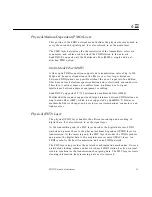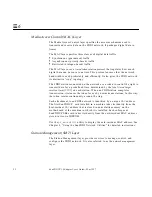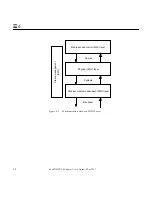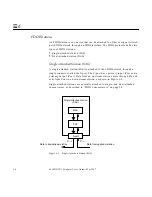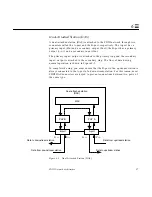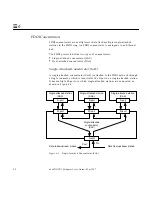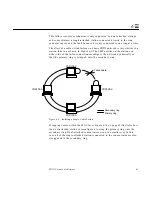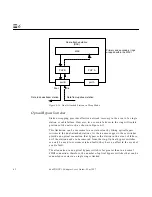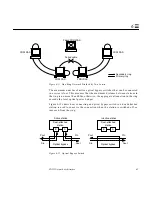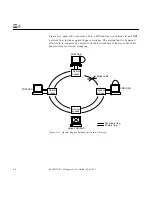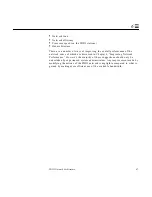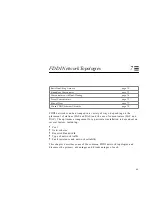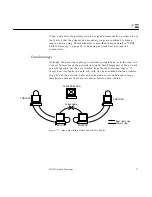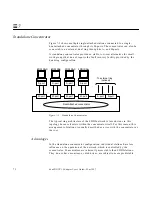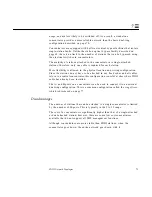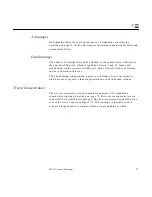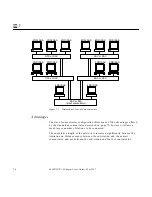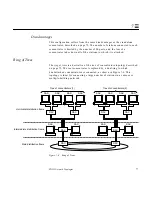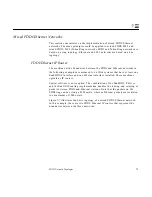
FDDI Network Architecture
65
6
FDDI Ring Operation
Two types of traffic are allocated bandwidth on an FDDI ring:
•
Asynchronous traffic (unrestricted and restricted)
The unrestricted asynchronous service allocates bandwidth dynamically
based on the timed token rotation protocol, and according to the priority
assigned to the traffic. It does not guarantee bandwidth; therefore,
unrestricted asynchronous traffic may be delayed on a heavily loaded
network.
The restricted asynchronous service allocates bandwidth for extended
transmission based on restricted token exchange between communicating
stations. During restricted transmission, the timed token rotation protocol is
suspended until the restricted token is released. The use of the restricted
asynchronous service is relatively rare.
Unrestricted Asynchronous Transmission
The FDDI network is most commonly used for unrestricted asynchronous
traffic. This is the default mode for SunFDDI and is the only mode supported
in a Solaris 1.x environment. Access to the FDDI ring is controlled by a
permission token, or right to transmit. The permission token is a special frame
that is passed between stations. Unlike the tokens used in a Token Ring
network, the FDDI permission token contains no additional information.
The station holding the permission token completes transmission either when
it has no more packets to transmit, or when its right to hold the token expires.
It then releases the token, which is now available for use by the next station on
the ring. In this way, the permission token rotates around the ring, at a rate
determined by the overall target token rotation time (TTRT).
The TTRT is established when the ring is initialized, based on a bidding
procedure called the claim process. During the claim process, each station puts
in a request (
T_req
) for the TTRT. The lowest bid or, the fastest rotation time
wins the claim process and is stored in 2’s complement form as the operating
value of TTRT (
T_opr
). The maximum value of TTRT (
T_max
) allowed by the
MAC
layer is implementation dependent, but is always in the ~165 ms range.
SunFDDI/P has
T_max
=167.874 ms.
Summary of Contents for 1.0
Page 13: ...Contents xiii Glossary 141 Index 147 ...
Page 14: ...xiv SunFDDI P 1 0 Adapter User s Guide May 1997 ...
Page 18: ...xviii SunFDDI P 1 0 Adapter User s Guide May 1997 ...
Page 25: ...Part1 InstallingandConfiguring SunFDDI P ...
Page 26: ......
Page 36: ...10 SunFDDI P 1 0 Adapter User s Guide May 1997 2 ...
Page 58: ...32 SunFDDI P 1 0 Adapter User s Guide May 1997 4 ...
Page 73: ...Part2 PlanningandImplementing SunFDDINetworks ...
Page 74: ......
Page 94: ...68 SunFDDI P 1 0 Adapter User s Guide May 1997 6 ...
Page 110: ...84 SunFDDI P 1 0 Adapter User s Guide May 1997 7 ...
Page 128: ...102 SunFDDI P 1 0 Adapter User s Guide May 1997 8 ...
Page 144: ...118 SunFDDI P 1 0 Adapter User s Guide May 1997 9 ...
Page 150: ...124 SunFDDI P 1 0 Adapter User s Guide May 1997 10 ...
Page 166: ...140 SunFDDI P 1 0 Adapter User s Guide May 1997 A ...
Page 172: ...146 SunFDDI P 1 0 Adapter User s Guide May 1997 ...
Page 182: ......

